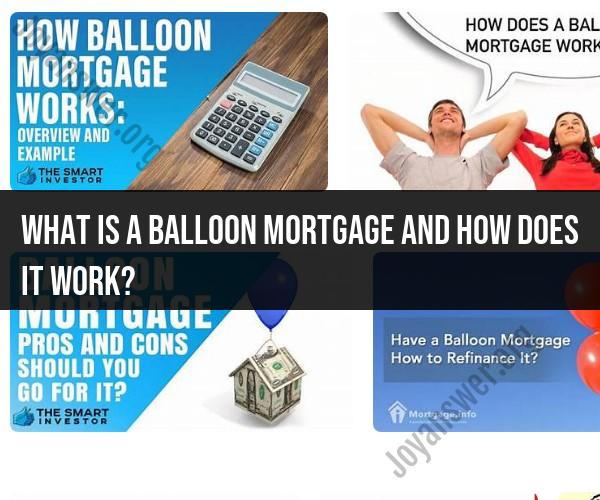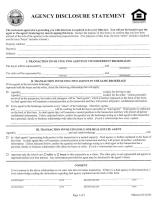What is a balloon mortgage and how does it work?
A balloon mortgage is a type of mortgage loan that has some similarities to a traditional fixed-rate or adjustable-rate mortgage, but it also has a unique feature: a large lump-sum payment, known as the "balloon payment," that becomes due at the end of the loan term. Balloon mortgages are not as common as traditional mortgage options, and they come with specific risks and benefits. Here's how a balloon mortgage works:
Initial Period of Fixed or Adjustable Interest: Like a traditional mortgage, a balloon mortgage typically starts with an initial period during which the interest rate is either fixed or adjustable. This initial period can vary but is usually shorter than the total loan term, often ranging from 5 to 7 years.
Lower Monthly Payments: During the initial period, borrowers benefit from lower monthly mortgage payments compared to what they might have with a fixed-rate mortgage with the same term. This can make homeownership more affordable during the early years of the loan.
Balloon Payment Due: At the end of the initial period, the borrower faces a substantial balloon payment. This payment includes the remaining principal balance of the loan, and it must be paid in full. The size of the balloon payment is determined when the loan is originated.
Options at the End of the Term: When the balloon payment becomes due, borrowers have several options:
- Refinance: One common option is to refinance the remaining balance into a new mortgage, spreading the repayment over a new term. This allows borrowers to continue homeownership without making the large lump-sum payment.
- Pay the Balloon: If the borrower has the financial means, they can pay the balloon payment in full. This option eliminates the mortgage debt entirely.
- Sell the Property: Some borrowers plan to sell the property before the balloon payment is due, using the proceeds from the sale to cover the payment.
- Negotiate with the Lender: In some cases, borrowers may negotiate with the lender to modify the loan terms, potentially extending the loan or converting it to a different type of mortgage.
It's important to understand the potential risks and benefits of a balloon mortgage:
Benefits:
- Lower initial monthly payments can make homeownership more accessible in the short term.
- It may be suitable for borrowers who expect a significant increase in income or plan to sell the property before the balloon payment is due.
Risks:
- The large balloon payment at the end can be financially challenging, and borrowers must be prepared to handle it.
- If property values decline or the borrower's financial situation changes, it can be difficult to refinance or sell the property to cover the balloon payment.
- Interest rates may have changed significantly by the time the balloon payment is due, affecting refinance options.
Balloon mortgages are not suitable for everyone and are considered riskier than traditional mortgages. Borrowers should carefully consider their financial situation and future plans before opting for this type of mortgage. Additionally, they should have a clear plan in place for addressing the balloon payment when it comes due. Consulting with a qualified mortgage advisor is essential to make an informed decision regarding a balloon mortgage.
Balloon Mortgages Demystified: How They Work and What to Expect
A balloon mortgage is a type of mortgage that does not fully amortize over the term of the loan. This means that the borrower makes lower payments for a set period of time, typically 3 to 7 years, and then a large balloon payment is due at the end of the term. The balloon payment is typically equal to the remaining balance of the loan.
Balloon mortgages can be appealing to borrowers who cannot afford the monthly payments on a traditional mortgage. However, it is important to understand the risks involved before taking out a balloon mortgage.
What to expect
When you take out a balloon mortgage, you will typically have a lower interest rate than you would on a traditional mortgage. However, your monthly payments will be higher at the end of the term when the balloon payment is due.
If you are unable to make the balloon payment at the end of the term, you will have to refinance the loan or sell your home. If you refinance the loan, you may have to pay a higher interest rate and/or longer repayment term. If you sell your home, you may not get enough money to pay off the loan balance, and you may have to make up the difference out of pocket.
Floating Through Mortgages: Understanding Balloon Mortgage Terms
Balloon mortgages can have a variety of terms, so it is important to understand the terms of your loan before you sign anything.
Term: The term of a balloon mortgage is the length of time that the borrower has to make the balloon payment. Balloon mortgages typically have terms of 3 to 7 years.
Interest rate: The interest rate on a balloon mortgage is typically lower than the interest rate on a traditional mortgage. However, the interest rate may adjust over time, depending on the terms of the loan.
Balloon payment: The balloon payment is the large payment that is due at the end of the term of the loan. The balloon payment is typically equal to the remaining balance of the loan.
Mortgage Matters: Navigating the World of Balloon Mortgages
Balloon mortgages can be a good option for borrowers who cannot afford the monthly payments on a traditional mortgage. However, it is important to understand the risks involved before taking out a balloon mortgage.
Here are some tips for navigating the world of balloon mortgages:
- Make sure you can afford the balloon payment. Before you take out a balloon mortgage, make sure that you have a plan for how you will make the balloon payment at the end of the term.
- Consider your options. There are other types of mortgages available, such as adjustable-rate mortgages (ARMs) and interest-only mortgages. Consider your options carefully and choose the type of mortgage that is best for your financial situation.
- Get pre-approved for a mortgage. Before you start shopping for a home, get pre-approved for a mortgage. This will give you an idea of how much money you can borrow and what your monthly payments will be.
- Shop around for a mortgage. Compare rates and terms from different lenders before you choose a mortgage.
- Read the fine print. Before you sign any loan documents, read them carefully and make sure you understand all of the terms and conditions.
If you are considering a balloon mortgage, be sure to talk to a financial advisor to make sure that it is the right option for you.












